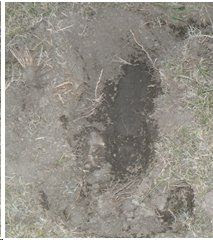While wandering the cemeteries I’ve started to notice a few things. Time may heal all wounds, but it doesn’t do much for graves or grave stones. While tiptoeing through the tombstones, I found ample evidence of how those tombstones disappear over the years. Here are some examples:
1. Time: As time passes, grass continues to grow and all too soon the grass can reclaim a tombstone.
1. Time: As time passes, grass continues to grow and all too soon the grass can reclaim a tombstone.
2. Gophers, ground squirrels and rabbits: Graveyards are known for their beauty and park like appearance. With the natural setting come the creatures that live in it, including those critters that like to dig and make holes. This can lead to two different problems. One, all that dug up earth can bury a gravestone. Two, tunnels under the tombstones can cause them to tilt, topple, or sink.
3. Vandalism: There are many reasons for vandalism. For some it’s to prove how “brave” they are against the dead. For others it’s because there’s “nothing better to do,” or just for pure wonton destruction. In ancient times this was done deliberately to “erase” the person from existence and for some it hasn’t changed. Once the stone is gone, so is the history that stone told. Sure, we keep records of who’s buried where, and we all know records never get lost or destroyed, right?
4. Modern Lawn care: You would think that along with maintaining the appearance of the graveyard that the primary concern would be to protect the gravestones from damage. But with the advent of modern lawn care equipment, we’ve seen more and more scenes like these. If you drive heavy equipment over something that was not designed for that kind of treatment you’re going to get:
5. Neglect: There are many graveyards that have seen better days and some are so overgrown and neglected that you need a GPS tracking system to find it. Some cemeteries have truly returned to their roots.
These are just a few of the problems facing we Graveyard Rabbits in our search of tombstones. We need to get motivated to prevent it! Do you donate to non-profit cemeteries? Are you a member of a cemetery preservation group? When you visit a cemetery, do you pick up the trash? Or brush off the tombstones? Pick a few weeds? If you said no to any of these, my question is simple ~ why not?
Tombstone Jack & Stachia











